As a prepper, you need to make a long-term plan for survival and sustainability. This plan should include raising animals for food, protection, and transportation.
In order to determine what’s best for you, the factors you need to consider are the size of your household, the location and size of your residence, and the costs of raising animals.
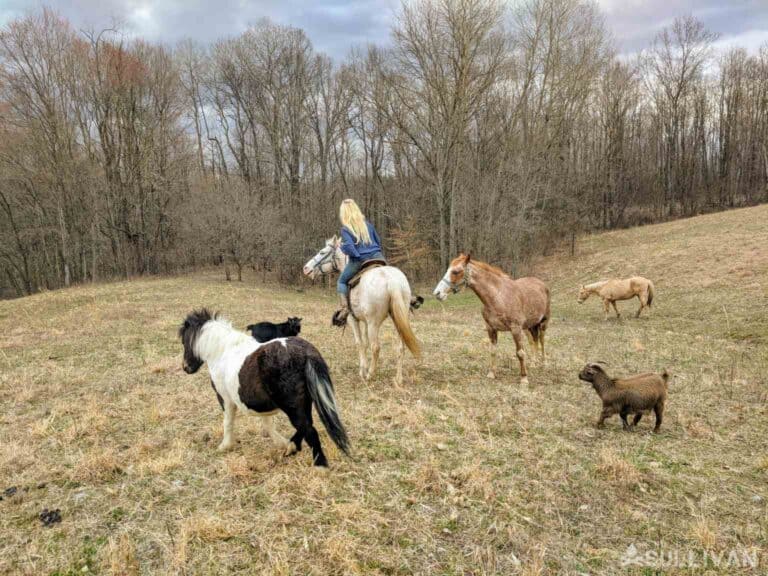
These may vary from family to family, so you need to think long and hard about the pros and cons of keeping animals. I’ll give you some more in-depth tips on choosing the right ones for your homestead below.
Table of Contents
How to Decide Which Animals to Raise
As I mentioned in the introduction, choosing which animals to raise on your homestead will likely come down to two things: personal preference, and how much space you have available.
In some places, there are regulations in place that will make it impossible for you to raise large livestock breeds, like goats, sheep, and cattle. However, you may still be able to raise chickens, rabbits, or perhaps a pig or two.
Do some research, though. Some municipalities are so strict that even chickens are prohibited, while others allow a flock of chickens as long as there is no rooster.
You’ll also want to consider your goals. Do you want to raise livestock for meat or milk? Fiber? Protection? Companionship? Some other product you can use to barter?
Next is space. As you can imagine, it’s going to be much more difficult for you to raise a herd of cattle if you live in the middle of New York City than it might be to raise meat rabbits (which you can easily raise inside or on a terrace, or even in an apartment).
Even if you have acres upon acres on which to raise your animals, remember that the best way to raise any species of livestock is to give them lots of room to roam.
This is more humane, and will also cut down on the amount of maintenance you have to do to keep your flock healthy (for example, parasite problems are far less common when animals are given several acres to graze rather than grazing the same patch of land consistently).
Finally, consider how much work you want to (or are able to) put into raising animals. Some animals, like chickens, just require a bit of feeding and watering each day. Others, like sheep, require constant maintenance.
You’ll have to shear them regularly, deworm them, trim hooves, and so on. Be realistic with yourself about how much time you have available!
#1. Chickens
In raising livestock, chickens usually make the top of the list of the best species to raise. Some breeds can lay an egg daily for a span of one to three years. Once egg production has fallen off, you can cook yourself some delicious stew with the butchered bird.
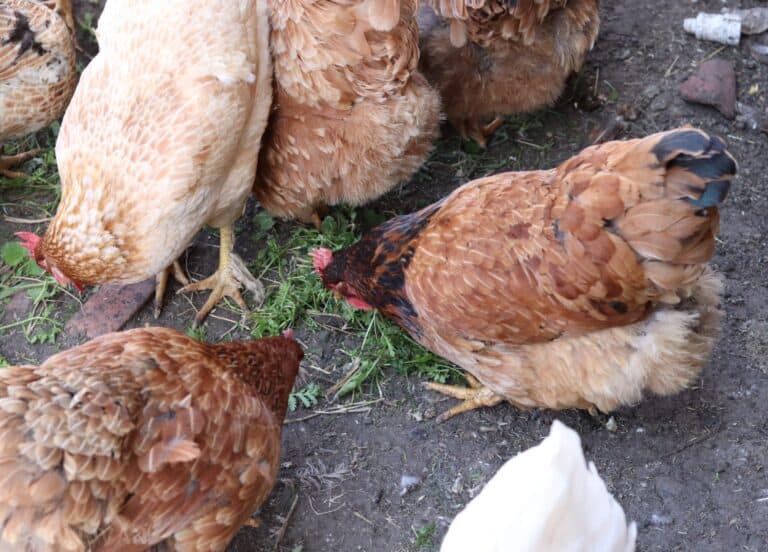
In addition, chicken feathers can also be used to make a decent pillow. Let’s not forget how valuable chicken manure is as a fertilizer, either!
To get started, you will need around three square feet of space for each chicken, some kind of shelter for them and nesting boxes. For a family of four, eight to ten hens can provide plenty of eggs for everyone.
Some good chicken breeds to consider include:
- Rhode Island Reds
- New Hampshire Reds
- Bantams
- White Leghorns
- Wyandottes
- Jersey Giants
Most of these chicken breeds are dual-purpose, meaning they can be raised both for eggs and meat. They can also be used to produce next year’s breeding stock.
Adding at least one rooster to the bunch is recommended if you want to increase your stock or barter with it, but roosters are not necessary in order for the hens to lay eggs.
They are necessary, however, if you plan on incubating your own eggs or allowing broody hens to sit on their own eggs.
Hens are relatively cheap, with each chick costing a few dollars, depending on the type and age when you buy them. Poultry is also great for pest control, they gobble up hornets, wasps, ants, and ticks.
Here’s the only guide you’ll ever need to start raising chickens.
#2. Pigs
Pigs are an excellent source of meat. They aren’t too difficult to care for and will eat pretty much anything.
They are ready for market in just a few months, too, meaning you don’t have to raise them during the winter and worry about freezing water, either.
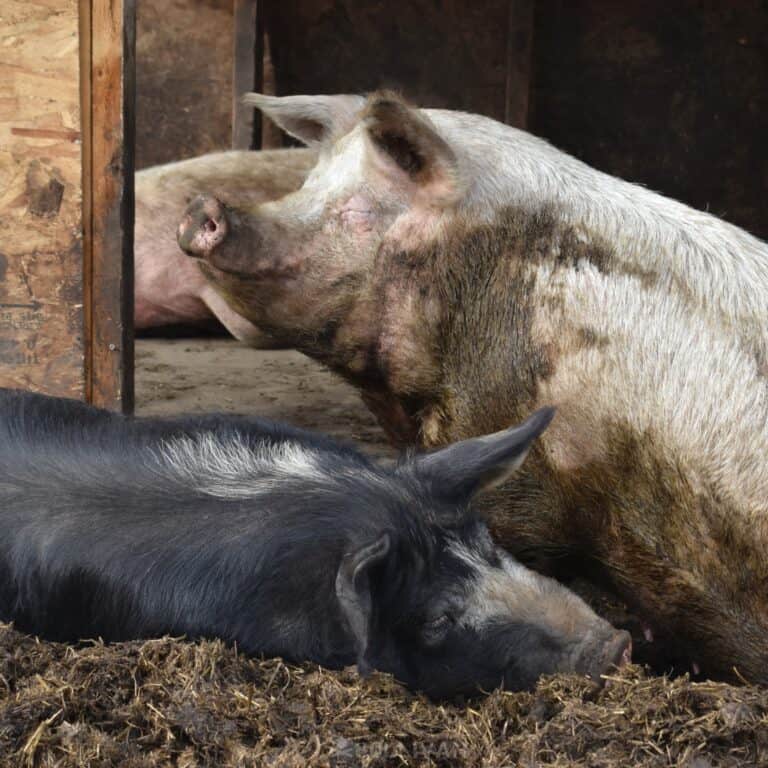
A sow can give birth twice a year, with 6-14 piglets per litter, enough for you to enjoy a lifetime supply of pork. Their manure can also be used as fertilizer for your garden if it is composted.
Keep in mind that pigs are social creatures so you need to have a couple of pigs to keep each other company. For an adult pig, you need to build a pen at least 50 square feet which will keep your pigs dry and warm.
You also need to build a secure fence around the shelter, as pigs are notorious for escaping their pens. I recommend using several strands of electric, as pigs can easily escape page wire and wooden fences.
Normally, pigs are given commercial feeds but in a post-SHTF scenario, you can formulate your own. Organic feeds are usually a combination of corn, wheat, salt, soybean, skim milk powder, and sorghum.
Some people even raise their pigs on pasture, though this is only recommended for certain breeds.
You can feed pigs your leftover food just as long as you keep it healthy. Be sure to provide plenty of water to keep them hydrated.
Some breeds of pigs you may want to consider for your homestead include:
- Duroc
- Yorkshire
- Tamworth
- Berkshire
- Gloucestershire White
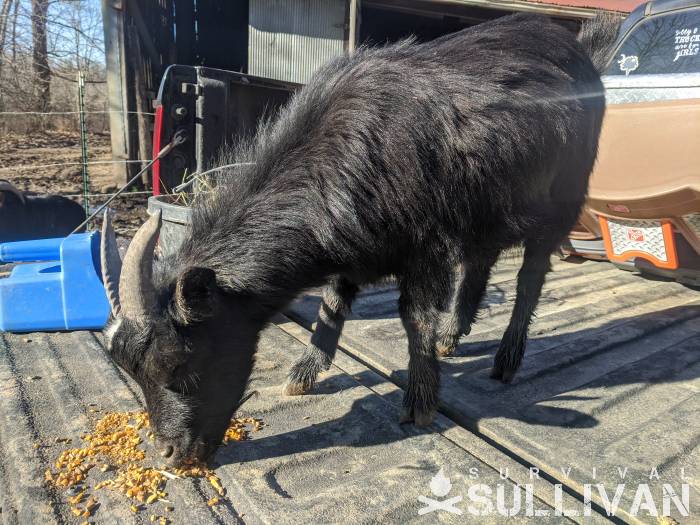
#3. Goats
When it comes to milk, most people would choose cow’s milk. However, if you want to be practical, goats may be a better choice.
Compared to cows, goats are a lot cheaper and require far less space and food. A goat can provide you all the milk you need and can give birth to two or three kids at a time, while cows typically only birth singletons.
Goat’s milk is easily digested and can be given to the entire family, even someone allergic to cow’s milk. A single goat can produce 2-4 quarts of milk daily which can also be made into cheese, butter, and soap.
When the milk runs out, the meat will make for a tasty dinner recipe. Furthermore, goats are a lot more manageable because of their small size. There are even goats you can raise for fiber!
There are a lot of breeds to choose from, depending on your needs. If you’re after milk, good examples would be Nubian, Saanen, or Lamancha goats.
When it comes to meat, you might want to consider Boer and Myotonic goats. On the other hand, Angora goats can supply you with enough mohair just in time to make warm gloves, hats, and scarves for winter.
Goats aren’t finicky in terms of feed – they’ll eat just about any kind of plant they encounter. However, you do need to plan on building sturdy fences, since they’re skilled escape artists.
#4. Sheep
Just like goats, sheep won’t take up much space and can be left to eat the grass and weeds growing in your yard. With most breeds of sheep, you can get milk, meat, and fiber all from one animal.
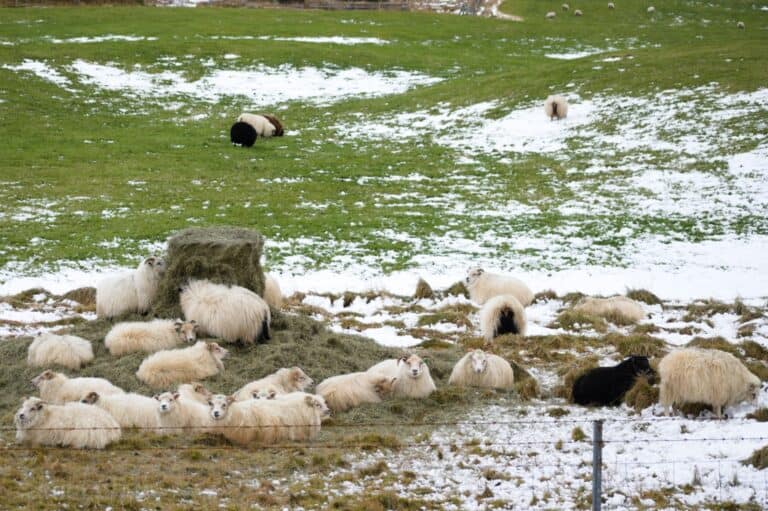
They are also popular livestock animals because they are highly trainable and easy to care for.
Some sheep breeds can give birth twice in a year to three lambs for each birthing event. This will enable you to increase your flock over time without too much effort.
To raise sheep, you will need to build a big fence around the perimeter to keep the sheep in and the predators out.
Sheep aren’t quite as adventurous as goats, but they do need to be protected from things like coyotes and wolves, so keep this in mind when constructing your fence.
Some versatile sheep breeds to consider for your farm include:
- Icelandic
- Katahdin
- Dorper
- Suffolk
- Hampshire
#5. Dogs
In a post collapse world, you must not only focus on acquiring food and shelter, but also on keeping your family safe.
For this purpose, it would be wise to get yourself a guard dog if you don’t already have one. Dogs can act as your early alert system, and can even go as far as fighting off burglars.
They can also be incredibly loyal and provide much needed companionship as well as entertainment for your children.
However, one drawback would be that as carnivores, a dog will also be another mouth to feed. This can become a problem if you are running low on food supply.
In choosing a suitable guard dog, you might want to go for large breeds such as Rottweiler, German Shepherds, Great Danes, and Staffordshire Terriers. When it comes to speed, an intruder won’t be able to outrun a Doberman.
If you decide to raise goats or sheep, you might want to consider a livestock guardian dog. Usually, these animals live outside with your livestock, and can provide much-needed protection from opportunistic predators.
#6. Catfish
To add some variety to your diet, you should think about growing some fish as part of your survival plan.
Catfish are a good choice as they can thrive in small spaces and they are also known to grow rapidly.
You can stock them in a pond, if you are lucky enough to have one, or you can even create your own aquaponics system to grow both fish and vegetables.
You can even raise catfish in a barrel. This freshwater species can simply be fed with earthworms from your garden supplemented with some grass carp to keep algae from thriving in the water.
To grow a large supply, it is best to feed them more often in the summer than winter, once or twice a day.
#7. Rabbits
Often considered pets, rabbits can provide meat and even wool. They are richer in protein than pork and beef.
They are one of the easiest animals to keep for meat as they only require a very small space, at least two square feet per rabbit, and can be fed with grass and weeds for sustenance.
Their droppings also make excellent fertilizer. Known for being highly prolific breeders, a doe can give birth to as many as 25 rabbits in a year! It won’t take long at all for you to build a stockpile of meat with just a couple of breeding pairs.
For a continuous supply of meat, you should have at least one buck and two does in your home. Getting started won’t break your budget either, since each one costs around five dollars.
As a word of advice, their cages should be regularly cleaned, for they are known for being smelly and messy.
Make sure you choose a breed of rabbit that is good for meat rather than one that is meant for fiber (unless you plan on harvesting the fur). Some good options include:
- Californian
- Flemish Giant
- New Zealand White
- American Chinchilla
#8. Bees
Before you run away, raising bees in your backyard is not as dangerous as you think. As long as you do your research and prepare well for it, you can enjoy a continuous supply of honey for you and your family.
Honey has numerous medicinal benefits and is a great source of energy. If you plan on starting your bee colony now, you need to check first the regulations and ordinances in your local community. Some areas have restrictions in place that make it difficult or impossible to raise backyard bees.
Once you have the legalities sorted out, you will need a space in your yard and to get yourself a beehive.
You should also purchase protective clothing to use when handling them.
Bees aren’t the cheapest animals you can start raising on your homestead, as there’s a lot of start-up cost in getting your hives going. You’ll need all kinds of gear, like gloves, a net, frames, honey extractors, and more.
However, this is a commodity that you can not only use as a sweetener on your own homestead, but you may also be able to use as a bartering tool in your community.
Finally, in choosing the type of bee, it’s best to get gentle bees such as Buckfast bees if you’re new to the game.
There are other, more productive species of bees you can raise, but they are also more aggressive – not something you want to have to deal with when you’re trying to learn how to work a hive!
Learn more about how to get started with bees right here.
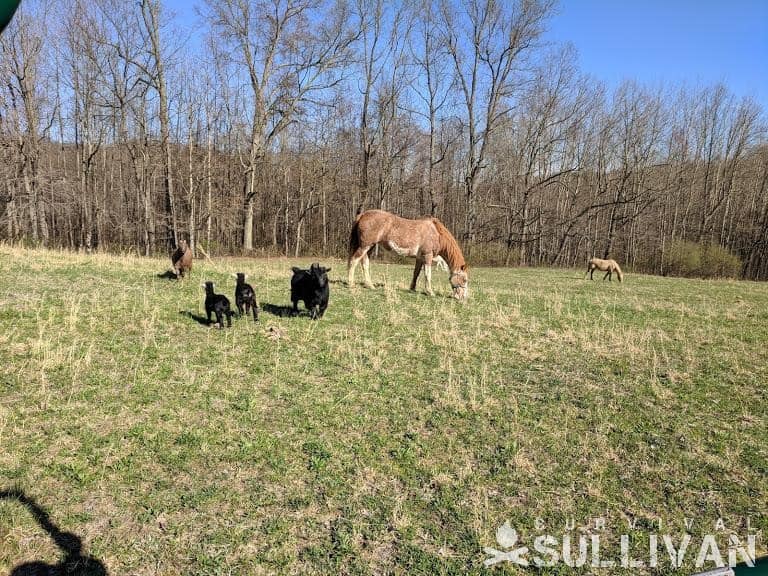
#9. Horses
In a post-SHTF scenario, cars may become a thing of the past. In this case, you should consider keeping horses if you have the means for it. Horses are good for traversing long distances and carrying heavy items.
In addition to feed and shelter, horses also need a lot of tender loving care which involves grooming, training, and bonding. Aside from lodging, they will need a lot of space for exercise, which should be done on a daily basis.
You need to provide plenty of grass and hay as a horse needs to eat around 15-20 pounds a day as well as clean drinking water.
You also need to organize a feeding schedule depending on their workload – remember, the more you work your horses, the more food they will require.
You should also be familiar with them and have some experience in riding them as horses can be very intuitive and can sense fear. It’s a good idea to invest your time in some training with someone who knows what he or she is doing.
Research the different breeds of horses to make sure you choose one that is more likely to be dependable in a post-SHTF environment. Some good options include:
- Belgians
- Percherons
- Clydesdales
- Suffolks
- Friesians
More on raising horses for survival and homesteading purposes in our other article.
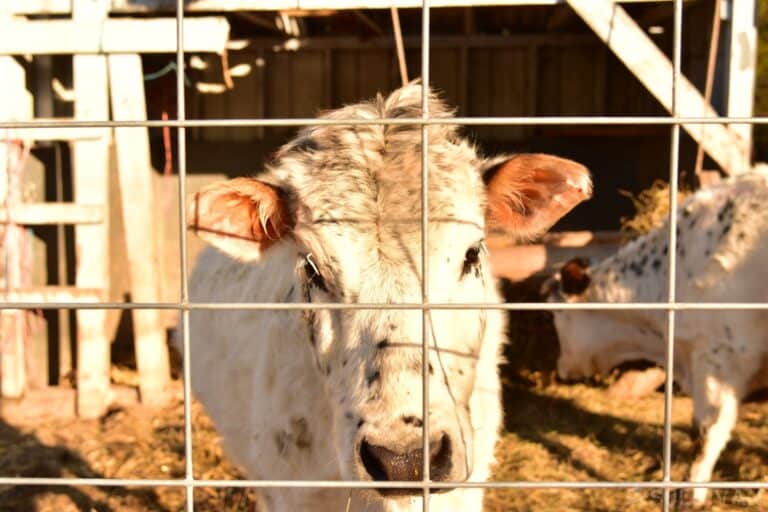
#10. Cattle
Just like keeping a horse, keeping a cow is a big responsibility. Cows need a large pasture to graze on especially if you’re planning to raise a reasonably-sized herd.
While they can survive on grass and hay, feeding them with grain and silage will fatten them up much more quickly.
They also need a lot of maintenance when it comes to their health, as you will be faced with worm and lice problems among other things if you are not diligent about preventing them.
But if you can pull this off, you will be rewarded with plenty of milk and beef to go around.
Some good cattle breeds for a homestead include:
- Angus
- Jersey
- Holstein
- Highland
Check out our full guide to raising cattle.
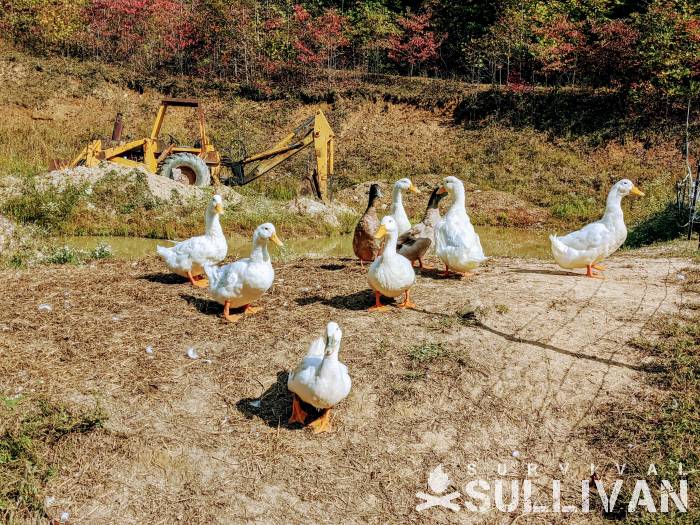
#11. Ducks
Raising ducks is another option you should consider when it comes to species for your homestead. Ducks not only provide a valuable source of meat and eggs, but they’re highly entertaining, too.
Contrary to popular belief, you don’t have to have a pond or water source on your property to raise ducks. You can easily replicate this kind of environment by using a kiddie pool. They are surprisingly quiet and are resilient to many diseases that tend to affect chickens, too.
Some good breeds to consider include:
- American Pekin
- Khaki Campbell
- Indian Runner
- Cayuga
- Welsh Harlequin
12. Turkeys
Turkeys take up quite a bit more space than chickens or ducks, but it’s a good idea to raise them for several reasons. The biggest is just that – they’re big!
Turkeys can grow quite large in a single season, but you can easily raise a bird that dresses out at 15, 20, or 25 pounds or more. Raising them is more or less the same as raising chickens – you’ll need high-quality feed and good housing.
Consider breeds like:
- Midget White
- Bourbon Red
- Broad-Breasted White
- Bronze
- Narragansett
- Royal Palm
13. Guineas
Guinea hens, unlike ducks, are certainly not the quietest poultry breeds you can raise. In fact, they’re quite chatty! However, guinea hens offer a variety of benefits in a survival situation.
First and foremost, you can eat both the meat and eggs. The eggs can be somewhat difficult to find, since guinea hens aren’t as easy to train to nesting boxes as chickens are.
However, the meat is tasty and rich in nutrients. You can also use the feathers for various crafting and homemaking purposes.
Guineas also raise quite the racket so they can be used as a sort of pseudo-security system for your farm. They are often raised for pest control, too, and are known for their ability to gobble up all kinds of pests, like ticks.
14. Donkeys
The humble homestead species to consider, donkeys are often overlooked but should be considered for several reasons.
The biggest is that they can be raised as livestock guardian spices to protect your sheep, goats, and even your poultry. They aren’t difficult to keep contained and can be fed with hay – very little maintenance required.
15. Alpacas or Llamas
Last but not least, alpacas and llamas both are good animals that you might want to consider raising if you need a source of fiber for your homestead in a survival situation.
They are similar in appearance as well as in how they are raised. However, llamas are known to be slightly more aggressive.
You can also raise these two creatures as livestock guardian animals! Llamas are frequently used as pack animals, too.
In Summary
As you might expect, raising these animals would be a lot easier if you’re living in the country. However, in an urban setting, you will likely make do with the limited space and may be better off with choosing smaller animals.
Nevertheless, raising livestock on your homestead certainly can – and should! – be done no matter the size.
Bear in mind that keeping these animals will require a lot of work and effort on everyone’s part so you need to discuss this first with the entire family before making a decision.
You should involve your kids in raising these animals to teach them the value of responsibility and hard work
In addition to providing food for your family, raising livestock can also provide a good living as society begins to rebuild. The dairy, eggs, and meat these animals provide will make good barter items in a post collapse scenario.
Are you currently raising any livestock in your home? Don’t forget to pin this article on your favorite Pinterest board for later!
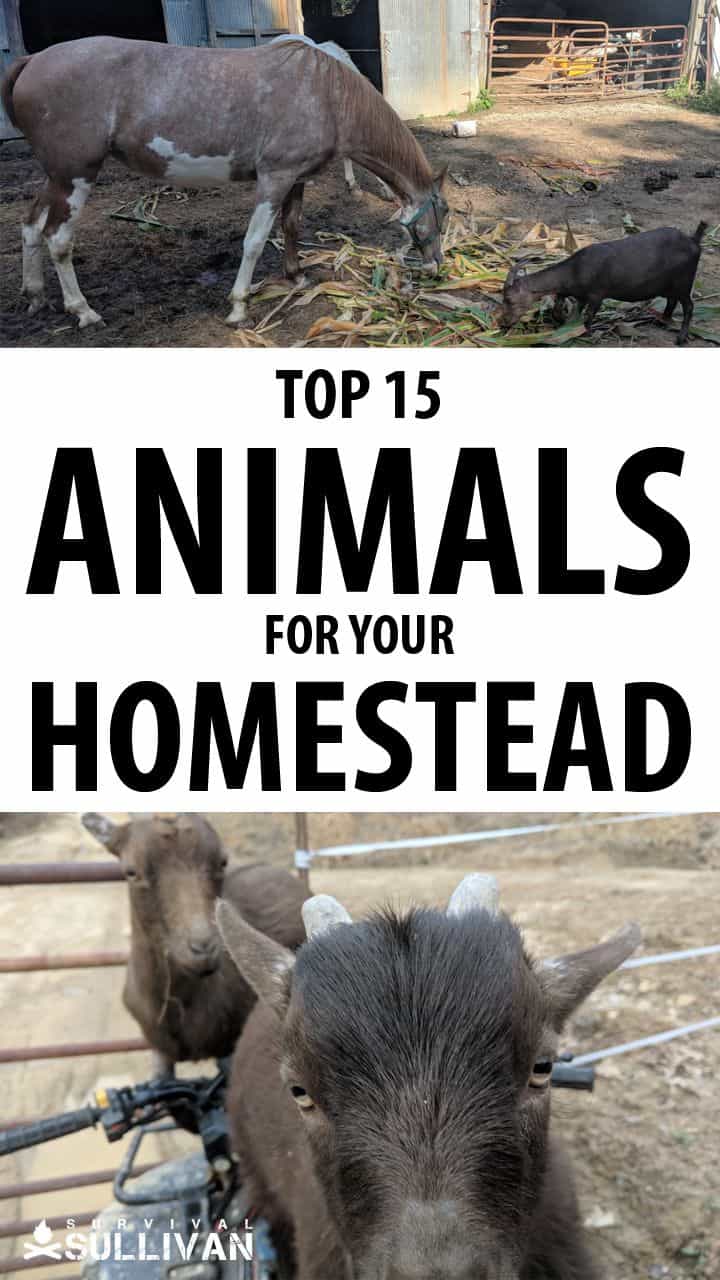

Although I teach high school English by day, I’m also the proud co-owner of a small, twenty-two acre property in New York (my second job and favorite pastime). We raise chickens, pigs, bees, and vegetables on our “homestead” and are proud to call our little slice of heaven home! When I’m not wrangling chickens or harvesting massive quantities of zucchini, I enjoy writing about common homesteading topics and other subjects.

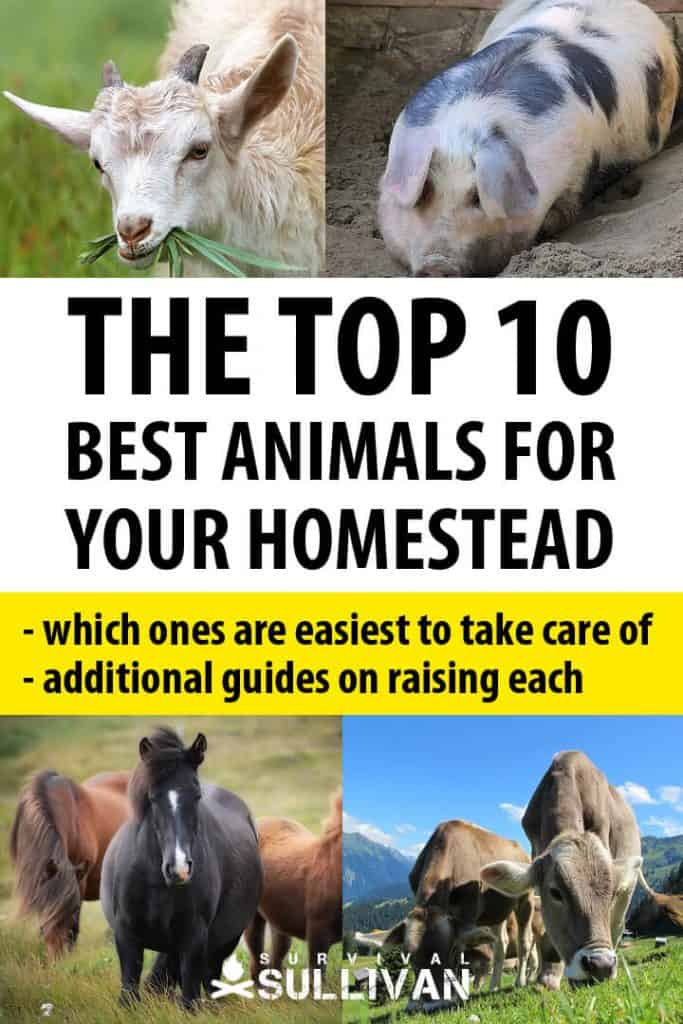
You need to grow worms to feed your compost and fish. this is really easy to do. There isn’t really any labor to speak of, just the initial startup.
Worms are a good high protein food for your chickens too.